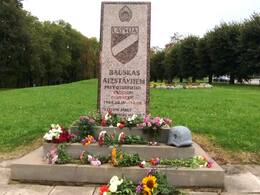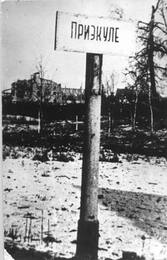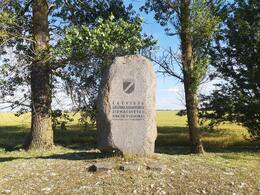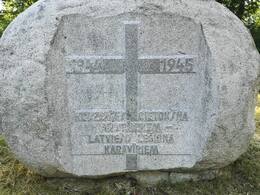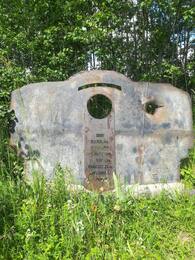Latvian Legion battles in Courland/Zemgalia 1944-1945
II World War II
At the end of July 1944, as the Red Army units were rapidly advancing from Lithuania towards the Gulf of Riga, units of the 15th Reserve and Training Brigade also began fighting in Zemgale. Particularly fierce fighting took place in Jelgava, where the Soviet 3rd Mechanized Corps attacked. Several improvised combat formations of various sizes were formed from the brigade units to defend the city. These 'alarm battalions' were unable to delay the Red Army's invasion of Jelgava, however, the battle line stabilized along the Lielupe River and remained there until mid-September. In early August, individual units of the brigade became part of the German units that participated in the attack to liberate Tukums and the coast of the Gulf of Riga. In October 1944, these units were included in the 19th Division. Latvian police battalions also participated in the battles around Bauska. These included the Bauska Volunteer Battalion, formed on July 23, 1944 from Bauska district police and guards, as well as the 23rd, 319th, and 322nd Latvian Police Battalions. The battalions were on the front lines until mid-September 1944, when they retreated after the Red Army attack and reached Courland in early October. The Courland Front was formed on October 10, 1944, when the Red Army launched an attack in the direction of Klaipėda with the aim of cutting off Army Group North's land traffic with Germany. On October 16, 1944, as the front line stabilized, 230,000 local residents and 150,000 refugees from other Latvian regions and the Soviet Union were trapped in Courland. Army Group "North" (from January 15, 1945 - "Kurland") included the 16th and 18th Armies with 32 divisions, including the 19th Division and several Latvian police battalions and construction battalions. Active hostilities in Kurland continued until the end of World War II. During the first two major battles of Kurland, the Soviet First and Second Baltic Fronts were tasked with destroying Army Group "North". The main directions of attack were: Liepaja for the First Baltic Front, Saldus for the Second Baltic Front. These operations were a complete failure, and the Red Army High Command decided to withdraw a large number of troops from Kurland, and to carry out further offensive operations with the aim of preventing the evacuation of Army Group "North" to Germany. During the Christmas Battles of 1944 (the third major battle of Kurland), the main striking force of the Second Baltic Front was involved 130th Latvian Rifle Corps. The 19th Division of the Latvian Legion and the 106th Latvian Regiment took up defensive positions in the intended direction of attack. This was the first time that Latvian units fighting on opposite sides were involved in a battle against each other. The Red Army continued its attacks until December 31, but it was unable to achieve the invasion and implement the objectives of the operation. During these battles, there were often cases when those fighting on one side captured acquaintances and even relatives of those fighting on the other side. In order to eliminate the protrusion created by the Red Army in the direction of Lestene, the VI Corps launched a successful counterattack on January 5, 1945. Although the Third Battle of Courland ended with the victory of the German Army Group “Courland”, the units of the troops in these battles, including the 19th Latvian Division, suffered very heavy losses. At the beginning of 1945, despite The active operations of the Red Army, more than ten divisions, including two tank divisions, were evacuated from Kurzeme. On February 16, 1945, the Soviet Second Baltic Front resumed active offensive operations. Latvian troops also took part in both warring sides, especially during the Sixth Battle of Kurzeme from March 18 to 31 in the vicinity of Blīdene. Continuous hostilities took place until the beginning of April, when the front stabilized on the line: Jūrmalciems-Priekule-Pampāļi - Saldus-Grenči-Radziņciems Klapkalnciems. In April 1945, both warring sides in Kurzeme continued to prepare for the next battles. However, taking into account the unconditional capitulation of the German armed forces, active hostilities in Kurzeme did not resume. On May 8, 1945, Army Group “Kurzeme” also capitulated. In captivity of the Red Army 286,000 soldiers of the German armed forces arrived, including some of the approximately 23,000 Latvian legionnaires in Courland.
More information sources
Latvian Legionnaires. Daugava Hawks. 2005, pp. 170-171.
Related timeline
Related objects
Monument to the defenders of Bauska against the Soviet occupation in 1944 in the Castle Garden
The monument to the defenders of Bauska in 1944 was unveiled on September 14, 2012, at the initiative of former Bauska Volunteer Battalion soldier Imants Zeltiņš and with his and the local government's financial support. The red granite stele, which is mounted on a three-tiered concrete base, is engraved with the text: “To the defenders of Bauska against the second Soviet occupation 1944.28.07.-14.09.” and “Latvia must be a Latvian state. Kārlis Ulmanis.” The unveiling of the monument was followed by protests from the Russian and Belarusian Foreign Ministries and local Russian mass media, but in the spring of 2024 the monument was even attacked by vandals. Despite this, a memorial event dedicated to the defenders of Bauska is held at this location every year on September 14 at 2:00 p.m.
At the end of July 1944, as the Soviet troops approached Bauska, there were no significant German forces in the city, which had recently been deep in the rear. The immediate fall of Bauska was prevented by the decisive action of Major Jānis Uļuks, the head of the Bauska district and commander of the guard regiment, who at the end of July formed the Bauska Volunteer Battalion, which consisted of guards of the 13th Bauska Guard Regiment, police officers, as well as volunteers. The battalion took up defensive positions on the banks of the Lielupe River in Jumpravmuiža opposite the Ziedoņi islet and on the first day it had to engage in battle with the attacking Red Army. Initially, the battalion was very poorly armed, and most of its automatic weapons had to be obtained as trophies. A few days later, the 23rd, 319th-F. and 322nd-F. Latvian police battalions also joined the war effort. Until mid-August, the 15th Latvian SS Reserve and Supplement Brigade Battalion, formed from training and medical companies, also participated in the defense of Bauska against the second Soviet occupation. In total, 3,000-4,000 Latvian soldiers participated in the battles for Bauska, who at the end of the battles had to face a tenfold superiority. Soviet troops managed to take Bauska only on September 14, after a month and a half of resistance by Latvian and German soldiers.
Monument to Victims of the Christmas Battles in Pienava
Located in Tukums region, on the side of the A9 highway, approximately a kilometer after Pienava in the direction of Liepāja.
The memorial is located on the site of the Third Battle of Courland, or the Christmas Battle, in 1944. At the end of World War II, a unique situation had developed in the territory of Latvia. There were German army forces in Courland, which the Red Army tried to eliminate or prevent from being involved in battles in East Prussia or around Berlin. “Courland Fortress” is the most common term used to describe the battles in Courland from 1944 to 1945. The “Courland Battle” was the German army’s military operations to repel the Red Army’s massive attacks. Latvian legionnaires also actively participated in the battles in Courland.
Today, you can visit the memorial site. The open fields of the area, without the oldest buildings, are witnesses to the war.
Memorial Stone to Defenders of the Kurzeme Fortification
Located in Tukums region, on the side of the A9 highway, 500 m from the turnoff to Lesteni in the direction of Riga.
The memorial was established in 1991 near the Rumbu houses, which were the scene of active hostilities. It is a tribute to the defenders of the “Courland Fortress” who fought against the Red Army in World War II. The battles were significant because they temporarily halted the Red Army’s complete occupation of Latvia. Approximately 300,000 Latvians emigrated to escape the crimes committed against civilians by the Soviet regime.
At the end of World War II, a peculiar situation had developed in the territory of Latvia. German army forces were located in Courland, which the Red Army tried to eliminate or prevent from being involved in battles in East Prussia or around Berlin. “Courland Fortress” is the most common term used to describe the hostilities in Courland from 1944 to 1945. “The Battle of Courland” was the German army’s fight to repel the Red Army’s massive attacks. The Courland Fortress ceased to exist shortly after Germany’s capitulation.
Today, you can visit the memorial and resting place, which was popular among Latvian legionnaires since the restoration of Latvia's independence.
Memorial to the Captain J. Ozols Artillery Regiment
A memorial sign for the 7th Battery of the 3rd Division, commanded by Major Jānis Ozols, has been installed on the side of the Riga - Liepāja highway, in Džūkste parish, approximately one kilometer from the Memorial Site for the Defenders of Kurzeme.
During the Third Battle of Courland from December 23 to December 31, 1944, Major J. Ozols' III Division repelled the enemy's superior attacks, preventing the front from breaking through. In this battle, Major J. Ozols demonstrated personal heroism and commanding abilities.
Jānis Ozols (1904-1947) was an officer of the Latvian Army and the Latvian Legion, a recipient of the Army's Honor Roll Buckle, as well as a national partisan and victim of Soviet repression.
Related stories
Report of Captain Jānis Ozols of the III./19. Artillery Regiment (2.Latvian) on the battles of December 24 and 25, 1944
The division commander, Captain Jānis Ozols, in his report of 27.12.1944 to the commander of the 15th (1st Latvian) SS Artillery Regiment, reports on the losses of the 7th, 8th and 9th battery guns in the battles of 24-25 December in the Zvejnieki - Dirba area.





